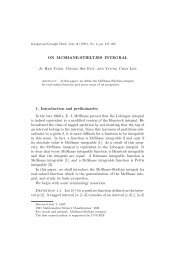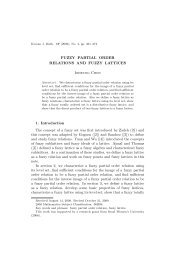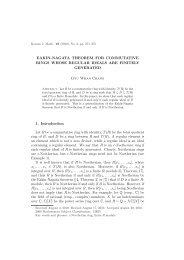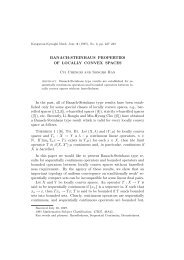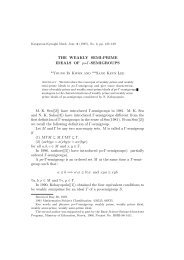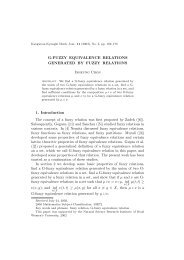CONVERGENCE AND POWER SPECTRUM DENSITY OF ARIMA ...
CONVERGENCE AND POWER SPECTRUM DENSITY OF ARIMA ...
CONVERGENCE AND POWER SPECTRUM DENSITY OF ARIMA ...
You also want an ePaper? Increase the reach of your titles
YUMPU automatically turns print PDFs into web optimized ePapers that Google loves.
Korean J. Math. 17 (2009), No. 4, pp. 399–409<br />
<strong>CONVERGENCE</strong> <strong>AND</strong> <strong>POWER</strong> <strong>SPECTRUM</strong> <strong>DENSITY</strong><br />
<strong>OF</strong> <strong>ARIMA</strong> MODEL <strong>AND</strong> BINARY SIGNAL<br />
Joo-Mok Kim<br />
Abstract. We study the weak convergence of various models to<br />
Fractional Brownian motion. First, we consider arima process and<br />
ON/<strong>OF</strong>F source model which allows for long packet trains and long<br />
inter-train distances. Finally, we figure out power spectrum density<br />
as a Fourier transform of autocorrelation function of arima model<br />
and binary signal model.<br />
1. Introduction<br />
Random processes find a wide variety of applications. The most common<br />
use is as a model for noise in physical systems. A second class<br />
of applications concerns the modeling of random phenomena that are<br />
not noise but are nevertheless unknown to the system designer. An<br />
example would be a signal and image processing, digital control and<br />
communications([4], [9]). On the other hand, the various models for capturing<br />
the long-range dependent nature of network traffic is proposed and<br />
self-similarity and long range dependence have been observed in many<br />
time series, i.e. network traffic and finance([1], [2], [3], [5], [6]). In particular,<br />
fractional Brownian motion, <strong>ARIMA</strong> model and binary signal<br />
in modern packet network traffic has been the focus of much attention<br />
([7]).<br />
In this paper we consider arrival process based on autoregressive process<br />
and F<strong>ARIMA</strong> process and show that the suitably scaled distributions<br />
of those processes converge to fractional Brownian motion in the<br />
sense of finite dimensional distributions. On the other hand, we consider<br />
Received September 12, 2008. Revised October 14, 2008.<br />
2000 Mathematics Subject Classification: 60G15, 60G18, 60G52 .<br />
Key words and phrases: Fractional Brownian motion, <strong>ARIMA</strong> model, binary signal<br />
model, power spectrum density.<br />
This work was supported by the Research Fund in Semyung University in 2008.
400 J. M. Kim<br />
idealized ON/<strong>OF</strong>F source model which allows for long packet trains and<br />
long inter-train distances. In particular, we figure out the coefficients of<br />
B H (t) and time t in the case of having Pareto distribution as ON/<strong>OF</strong>F<br />
periods. Finally, we has considered power spectrum densities of arima<br />
process and binary signal process.<br />
In section 2, we define short range dependence, long range dependence,<br />
fractional Brownian motion, farima process and power spectrum<br />
denity. In section 3, we prove the weak convergence to Fractional Brownian<br />
motion of arima process. In section 4, we consider ON/<strong>OF</strong>F source<br />
model which allows for long packet trains and long inter-train distances.<br />
In section 5, we figure out power spectrum density of arima process and<br />
binary signal process.<br />
2. Definition and preliminary<br />
In this section we first define short range dependence, long range<br />
dependence, Fractional Brownian motion, F<strong>ARIMA</strong> process and power<br />
spectrum density. Let τ X (k) be the covariance of stationary stochastic<br />
process X(t), i.e. τ X (k) = Cov(X(t), X(t + k)).<br />
Definition 2.1. A stationary stochastic process X(t) exhibits short<br />
range dependence if<br />
∞∑<br />
|τ X (k)| < ∞<br />
k=−∞<br />
Definition 2.2. A stationary stochastic process X(t) exhibits long<br />
range dependence if<br />
∞∑<br />
|τ X (k)| = ∞<br />
k=−∞<br />
Definition 2.3. A stochastic process {B H (t)} is said to be a Fractional<br />
Brownian motion(F BM) with Hurst parameter H if<br />
1. B H (t) has stationary increments<br />
2. For t > 0, B H (t) is normally distributed with mean 0<br />
3. B H (0) = 0 a.s.<br />
4. The increments of B H (t), Z(j) = B H (j + 1) − B H (j) satisfy<br />
τ Z (k) = 1 2 {|k + 1|2H + |k − 1| 2H − 2k 2H }
Convergence and power spectrum density 401<br />
Definition 2.4. A stationary process X t is called a F<strong>ARIMA</strong>(p, d,<br />
q) process if<br />
φ(B)∇ d X t = θ(B)Z t<br />
where φ(B) = 1 − φ 1 B − · · · − φ p B p , θ(B) = 1 − θ 1 B − · · · − θ q B q and<br />
the coefficients φ 1 , · · · , φ p and θ 1 , · · · , θ q are constants,<br />
∇ d = (1 − B) d =<br />
k=1<br />
∞∑<br />
b i (−d)B i<br />
and B is the backward shift operator defined as B i X t = X t−i and<br />
i∏ k + d − 1 Γ(i + d)<br />
b i (−d) =<br />
=<br />
k Γ(d)Γ(i + 1) .<br />
Now, we define a density for average power versus frequency for widesense<br />
stationary process.<br />
Definition 2.5. Let R XX (τ) be an autocorrelation function. Then<br />
we define the power spectrum density(PSD) S XX (ω) to be its Fourier<br />
transform (if it exits), that is,<br />
S XX (ω) =<br />
∫ ∞<br />
−∞<br />
3. Convergence of <strong>ARIMA</strong><br />
i=0<br />
R XX (τ)e −iωτ dτ.<br />
Let X j (i) be the number of arrivals in the ith time unit of jth<br />
source. Let<br />
M∑<br />
X M (i) = (X j (i) − E(X j (i)),<br />
j=1<br />
and τ(k) denote the covariance of X 1 (i).<br />
Lemma 3.1. ([6]) The stationary sequence<br />
1<br />
M 1/2 X M(i)<br />
converges in the sense of finite dimensional distributions to G H (i), where<br />
G H (i) represents a stationary Gaussian process with covariance function<br />
of the same form as τ(k), as M → ∞.
402 J. M. Kim<br />
Lemma 3.2.<br />
lim<br />
lim<br />
T →∞ M→∞<br />
[T t]<br />
1 ∑<br />
T H M 1/2<br />
i=0<br />
X M (i)<br />
converges to {σ 0 B H (t)|0 ≤ t ≤ 1} in the sense of finite dimensional<br />
distributions.<br />
(a) (Long Range dependence) If<br />
τ(k) ∼ ck 2H−2 , c > 0 and 1/2 < H < 1,<br />
then σ0 2 c<br />
=<br />
H(2H − 1) .<br />
(b) If<br />
∞∑<br />
∞∑<br />
|τ(k)| < ∞ and τ(k) = c > 0,<br />
k=1<br />
then σ 2 0 = c.<br />
(c) (Short Range dependence)<br />
k=1<br />
τ(k) ∼ ck 2H−2 , c < 0 and 0 < H < 1/2,<br />
then σ0 2 c<br />
=<br />
H(2H − 1) .<br />
Proof. Set Z i = 1/M 1/2 X M (i). By Lemma 3.1, Z i converges in the<br />
sense of finite dimensional distributions to G H (i) as M goes to infinity.<br />
By Theorem 7.2.11 of [7], the finite dimensional distributions of<br />
T ∑ −H [T t]<br />
i=0 Z i converges to those of {σ 0 B H (t), 0 ≤ t ≤ 1}.<br />
We consider a F<strong>ARIMA</strong>(p, d, q) which is both long range dependent<br />
and has heavy tails. F <strong>ARIMA</strong>(p, d, q) processes are capable of modeling<br />
both short and long range dependence in traffic models since the effect<br />
of d on distant samples decays hyperbolically as the lag increases while<br />
the effects of p and q decay exponentially.<br />
Theorem 3.3 (F<strong>ARIMA</strong>(0,d,0)). Let X i (j) = b i (−d)a j−i . Then<br />
[T t]<br />
lim lim 1 ∑ M∑ √<br />
(X j c<br />
(i)) =<br />
T →∞ M→∞ T H M 1/2 H(2H − 1) B H(t).<br />
Proof.<br />
τ(k) =<br />
j=0<br />
i=1<br />
(−1)k (−2d)!<br />
(k − d)!(−k − d)! ∼ ck2d−1 as k → ∞
Convergence and power spectrum density 403<br />
where H = d + 1/2, −1/2 < d < 1/2 and c =<br />
Lemma 3.2, we get the result.<br />
Γ(1 − 2d) sin(πd)<br />
. By<br />
π<br />
4. Convergence of binary signal<br />
Suppose that there are M i.i.d. sources. Since each source sends its<br />
own sequence of packet trains, it has its own reward sequence X (m) (t).<br />
Therefore, the cumulative packet count at time t is<br />
M∑<br />
X (m) (t).<br />
m=1<br />
Rescaling time by a factor T , we consider the aggregated cumulative<br />
packet counts<br />
∫ T t M∑<br />
X M (T t) = ( X (m) (u))du<br />
in the interval [0, T t].<br />
0<br />
Lemma 4.1. The aggregate packet process {X M (T t), t ≥ 0} behaves<br />
statistically like<br />
for large M and T .<br />
Proof. ([8], Theorem 1)<br />
m=1<br />
T M µ 1<br />
µ 1 + µ 2<br />
t + T H√ L(t)M σB H (t)<br />
To specify the distributions of ON-period O 1 and <strong>OF</strong>F-periods O 2 ,<br />
let<br />
µ 1 = EO 1 , µ 2 = EO 2<br />
and as x → ∞, tailing distributions of O 1 , O 2 are<br />
l 1 x −α 1<br />
L 1 (x) and l 2 x −α 2<br />
L 2 (x)<br />
with 1 < α j < 2, where is a constant l j > 0 and L j > 0 is a slowly<br />
varying function at infinity.
404 J. M. Kim<br />
Notation. When 1 < α j < 2, set<br />
If 0 < b < ∞ then set<br />
a j = l j (Γ(2 − α j ))/(α j − 1),<br />
σ 2 =<br />
if b = 0 or b = ∞ then set<br />
σ 2 =<br />
b = lim<br />
t→∞<br />
t α 2−α 1<br />
L 1 (t)<br />
L 2 (t) .<br />
2(µ 2 2a 1 b + µ 2 1a 2 )<br />
(µ 1 + µ 2 ) 3 Γ(4 − α min ) ,<br />
2µ 2 maxa min<br />
(µ 1 + µ 2 ) 3 Γ(4 − α min ) .<br />
Suppose that ON/<strong>OF</strong>F periods O j has the Pareto distribution, then<br />
P (O j > x) = K α j<br />
x −α j<br />
for x ≥ K > 0.<br />
Each periods has infinite variance in the case of 1 < α j < 2.<br />
Theorem 4.2. Let O j be ON/<strong>OF</strong>F-periods that has the Pareto distributions<br />
as above. Then, for large M and T , the aggregate packet<br />
process {X M (T t) | t ≥ 0} behaves statistically like<br />
T M α 1α 2 − α 1<br />
2α 1 α 2 − α 1 − α 2<br />
t + T H σB H (t)<br />
where, H = (3 − α min )/2 .<br />
Case 1. Suppose that O j have the same distributions, i.e., α 1 = α 2 = α,<br />
then<br />
H = 3 − α<br />
2<br />
and<br />
σ 2 = Kα−1 Γ(2 − α)<br />
2αΓ(4 − α)<br />
Case 2. If α 1 < α 2 , then<br />
and<br />
H = 3 − α 1<br />
2<br />
σ 2 = 2K2 α 2 1(α 1 − 1)(α 2 − 1) 3 a min<br />
(2α 1 α 2 K − α 1 K − α 2 K) 3<br />
Case 3. If α 1 > α 2 , then<br />
H = 3 − α 2<br />
2
and<br />
Convergence and power spectrum density 405<br />
σ 2 = 2K2 α 2 2(α 2 − 1)(α 1 − 1) 3 a min<br />
(2α 1 α 2 K − α 1 K − α 2 K) 3<br />
Proof. Since the expectation of the Pareto distribution is<br />
α j K<br />
α j − 1<br />
for j = 1, 2, · · · . By Lemma 4.1, the coefficient of time t is<br />
α 1 α 2 − α 1<br />
2α 1 α 2 − α 1 − α 2<br />
.<br />
Case 1. Since O j have the same distributions, we get<br />
And we know<br />
Thus, we get<br />
lim<br />
t→∞ tα 2−α 1<br />
= 1.<br />
α 1 = α 2 = K α Γ(2 − α)/(α − 1).<br />
σ 2 = Kα−1 Γ(2 − α)<br />
2αΓ(4 − α)<br />
In the similar way, we can get Case 2 and Case 3.<br />
Let X j (t) = 1 mean that there is a packet at time t and X j (t) = 0<br />
means that there is no packet. Viewing X j (t) as the reward at time<br />
t, we have a reward of 1 throughout an ON-period, then a reward of 0<br />
throughout the following <strong>OF</strong>F-period, then 1 again, and so on.<br />
Theorem 4.3. Let X j (i) denote the increment process for the ith<br />
stationary binary sequence X j (t). Then<br />
lim<br />
lim<br />
T →∞ M→∞<br />
⎧<br />
1 ⎨<br />
T H M 1/2 ⎩<br />
[T t]<br />
∑<br />
j=0<br />
⎫<br />
M∑<br />
(X j (i))− µ ⎬ √<br />
1Mt<br />
µ 1 + µ 2 ⎭ = c<br />
H(2H − 1) B H(t).<br />
i=1<br />
Proof. We get<br />
τ(k) ∼ ck 2H−2 ,<br />
as k → ∞ and<br />
E[X j (i)] = µ 1<br />
µ 1 + µ 2<br />
if E[On period] = µ 1 and E[Off period] = µ 2 . By Lemma 3.2, we get<br />
the result.
406 J. M. Kim<br />
5. Power spectrum density of <strong>ARIMA</strong> and binary signal<br />
Using the backshift operator B, the ARMA(p, q) model is expressed<br />
as<br />
(1 − ρ 1 B − · · · − ρ p B p )Y t = (1 − θ 1 B − · · · − θ q B q )e t ,<br />
where e t ∼ N(0, σ 2 ) is white noise. Replace B j with e iωj , getting<br />
on the autoregressive and<br />
A(ω) = 1 − ρ 1 e iω − ρ 2 e iω2 − · · · − ρ p e iωp<br />
M(ω) = 1 − θ 1 e iω − θ 2 e iω2 − · · · − θ q e iωq<br />
on the moving average side. Start with the spectral density of e t , which<br />
is σ 2 /2π. The spectral density for ARMA(p, q) process Y t becomes<br />
f Y (ω) = σ2 M(ω)M ∗ (ω)<br />
2π A(ω)A ∗ (ω) ,<br />
where A ∗ (ω) and M ∗ (ω) are corresponding complex conjugate expressions<br />
of the complex polynomial A(ω) and M(ω).<br />
Figure 1. PSD of AR(0.8) and AR(−0.8)<br />
For autoregressive order 1 series AR(1), the theoretical spectral density<br />
is<br />
1<br />
f(ω) =<br />
2π(1 + ρ 2 − 2ρ cos(ω)) ,<br />
where ρ is the lag 1 autoregressive coefficient. Power spectrum density<br />
in the case of ρ = 0.8, −0.8 is sketched in Figure 1.<br />
For a moving average MA(1) such as X t = e t − θe t−1 , the spectral<br />
density is<br />
f X (ω) = 1<br />
2π (1 + θ2 − 2θ cos(ω)).
Convergence and power spectrum density 407<br />
Figure 2. PSD of MA(0.7) and MA(−0.7)<br />
Figure 3. PSD of ARMA(0.8, 0.7) and ARMA(−0.8, 0.7)<br />
Power spectrum density in the case of θ = 0.7, −0.7 is sketched in Figure<br />
2.<br />
If Y t has spectral density<br />
f Y (ω) =<br />
1<br />
2π(1 + ρ 2 − 2ρ cos(ω))<br />
and is filtered to get D t = Y t − θY t−1 , then the spectral density is<br />
f D (ω) = (1 + θ 2 − 2θ cos(ω))f Y (ω)<br />
= 1<br />
2π (1 + θ2 − 2θ cos(ω))/(1 + ρ 2 − 2ρ cos(ω)).<br />
Power spectrum density in the case of ρ = 0.8, θ = 0.7 and ρ = −0.8, θ =<br />
0.7 is sketched in Figure 3.<br />
On the other hand, we construct the RTS(random telegraph signal)<br />
on t ≥ 0 as follows. Let X(0) = ±a with equal probability. Then take<br />
the Poisson arrival time sequence T [n] and use it to switch the level of
408 J. M. Kim<br />
Figure 4. PSD of λ = 100 and λ = 50<br />
the RTS, i.e., at T [1] switch the sign of X(t), and then at T [2], and<br />
so forth. Clearly from the symmetry and the fact that the interarrival<br />
times τ[n] are stationary and form an independent random sequence, we<br />
must have µ X (t) = 0 and that P X (a) = P X (−a) = 1/2. Let t 2 > t 1 > 0,<br />
and consider<br />
along with<br />
Then the correlation function is<br />
R XX (t 1 , t 2 ) = E[X(t 1 )X(t 2 )]<br />
P X (x 1 , x 2 ) = P [X(t 1 ) = x 1 , X(t 2 ) = x 2 ]<br />
P X (x 2 |x 1 ) = P [X(t 2 ) = x 2 |X(t 1 ) = x 1 ].<br />
= 1 2 a2 (P X (a|a) + P X (−a| − a) −P X (−a|a) −P X (a| − a)).<br />
Hence, writing the average number of transitions per unit time as λ,<br />
and substituting τ = t 2 − t 1 , we get<br />
R XX (τ) = a 2 e −λτ<br />
∑<br />
(−1) k (λτ)k = a 2 e −2λ|τ| .<br />
k!<br />
all k≥0<br />
The power spectral density of the autocorrelation function R XX (τ) is<br />
S XX (ω) =<br />
4λ<br />
4λ 2 + ω 2 .<br />
Power spectrum density of RTS signal in the case of λ = 100 and λ = 50<br />
is sketched in Figure 4.
Convergence and power spectrum density 409<br />
References<br />
[1] C. S. Chang and T. Zajic, Effective Bandwidths of departure processes from<br />
Queues Time Varying Capacities, IEEE INFOCOM’95(1995), Boston.<br />
[2] N. G. Duffield and N. O’Connell, Large daviations and overflow probabilities for<br />
the general single-server queue with applications, Math. Proc. Com. Phil. Soc.,<br />
118(1995), 363-374.<br />
[3] F. Kelly, Notes on effective bandwidths, Stochastic networks, Theory and applications,<br />
1996, 141-168.<br />
[4] N. Laskin, I. Lambadaris, F. Harmantzis and M. Devetsikiotis, Fractional Levy<br />
Motions and its application to Network Traffic Modeling, Submitted.<br />
[5] P. Rabinovitch, Statistical estimation of effective bandwidth, Information and<br />
System Sciences, 2000.<br />
[6] B. Sikdar and K. S. Vastola, On the Convergence of MMPP and Fractional<br />
<strong>ARIMA</strong> processes with long-range dependence to Fractional Brownian motion,<br />
Proc. of the 34th CISS, Prinston, NJ, 2000.<br />
[7] G. Samorodnitsky and M. S. Taqqu, Stable non-Gaussian processes: Stochastic<br />
models with Infinite Variance, Chapman and Hall, New York, London, 1994.<br />
[8] M. S. Taqqu, V. Teverovsky and W. Willinger, Estimators for long-range dependence<br />
: Empirical study, Fractals, 3(4), 785-798, 1995.<br />
[9] M. S. Taqqu, W. Willinger and R. Sherman, Proof of a fundamental result in<br />
self-similar traffic modeling, Computer Communication review, Preprint, 1997.<br />
School of General Education<br />
Semyung University<br />
Jecheon 390-711, Korea<br />
E-mail: jmkim@semyung.ac.kr



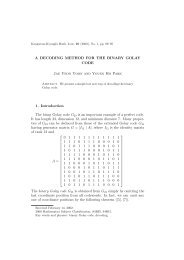
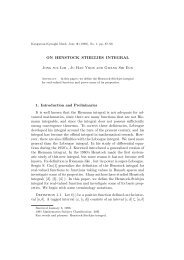
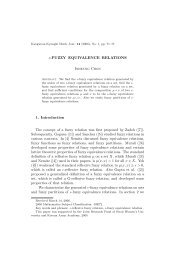
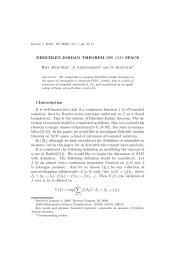

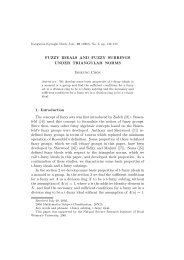
![SEMI-REGULAR po-SEMIGROUPS SK Lee J. Calais([1])](https://img.yumpu.com/46211509/1/184x260/semi-regular-po-semigroups-sk-lee-j-calais1.jpg?quality=85)
